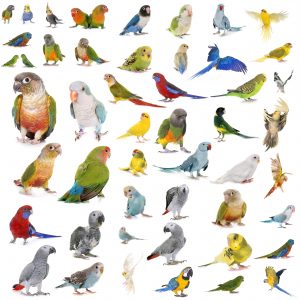Fabio Marcolin and his colleagues study how different evolutionary pressures affect bird song. This study is focused on parrots, and tested four theories about how birds evolve their specific song.
Why do birds sing the way they do? To answer this question, these scientists focused on parrots, and they used recordings of 252 species’ songs collected through a citizen science project.

Examples of different kinds of parrots
These scientists tested four main theories about why birds evolve their songs.
- The type of song depends on body size; big birds sing low songs and small birds sing high songs
- The song depends on habitat; birds that live in the forest sing lower than birds that live in the open so that their songs can be heard better
- The song depends on sociality; highly social birds have more complex calls because they need to spread more information
- The song depends on sexual selection; either female birds tend to choose males with pretty songs, or female birds choose male birds with pretty plumage so the fancy looking birds don’t need pretty songs
The scientists tested this by measuring the tone, frequency, and bandwidth of the parrot’s calls. They found that only body size and sexual selection seem to affect the evolution of bird song. The authors found no relationship between habitat and bird song or sociality and bird song.
As expected, they did find a relationship between size and song. This makes sense, intuitively because bigger things make lower sounds (imagine the biggest key on a xylophone).
Additionally they found that sexual selection also seems to affect the evolution of bird song. It might seem like female birds would prefer males that were more elaborate both in plumage and in song. Counterintuitively though, these scientists found that the fancier male birds tended to have simpler songs. This aligns with the “transference hypothesis”, which states that strong selection for one type of trait (like plumage) will relieve or reduce selection on other traits (like song).
Studies like this, that study such an extensive range of one group of animals, help us learn more about evolution in general. We learn which of our theories about evolution play out in real life and which do not, and we see here that the theories are not always accurate. The more we learn about evolution, the more we can know about the story of the amazing variety of life around us.
